Abstract
1. At work rates which do not result in a sustained increase in blood lactate ([L-]), oxygen uptake (VO2) approaches the steady state with first-order kinetics. However, when [L-] is increased, at least two kinetic components are required to characterize the VO2 response dynamics. The purpose of the present investigation was to determine whether these more-complex kinetics are best represented as: (a) two components which operate throughout the exercise or (b) a delayed slow component which is consequent to the lactic acidaemia and which does not influence the early development of the O2 deficit. 2. Six healthy subjects underwent an incremental ramp test on a cycle ergometer, to the limit of tolerance, for determination of the maximum VO2 (micro VO2) and and estimation [symbol: see text] of the threshold for lactic acidaemia (theta L) non-invasively. Subjects then performed, on different days, two to four repetitions of square-wave exercise from a baseline of unloaded pedalling ('O' Watts (W)) to work rates (WR) less than theta L (90% theta L) and greater than theta L (half-way between theta L and micro VO2). Ventilatory and pulmonary gas exchange variables were determined breath-by-breath. For each subject, the VO2 transitions were averaged prior to fitting a least-squares algorithm to the on- and off-transient responses. 3. The less than theta L test resulted in a mono-exponential VO2 response, with a time constant of 31.3 and 31.5 s for the on- and off-transients, respectively. 4. The VO2 responses to the greater than theta L test were fitted to three competing models: (a) a single exponential for the entire period; (b) a double exponential for the entire period; and (c) an initial single exponential with a subsequent phase of delayed onset. Model (c) yielded a significantly lower residual mean-squares error than methods (a) and (b), with a time constant for the initial component of 40.2 s for the on-transient and 32.9 s for the off-transient and a subsequent phase of VO2 increase for the on-transient which averaged 230 ml min-1. The delta VO2/delta WR for the early kinetics of the greater than theta L test were not different from the less than theta L test (9.6 and 9.5 ml min-1 W-1, respectively). 5. These data suggest that the slow phase of the greater than theta L VO2 kinetics is a delayed-onset process. This being the case, the O2 deficit during heavy exercise, as conventionally estimated, would be overestimated.
Full text
PDF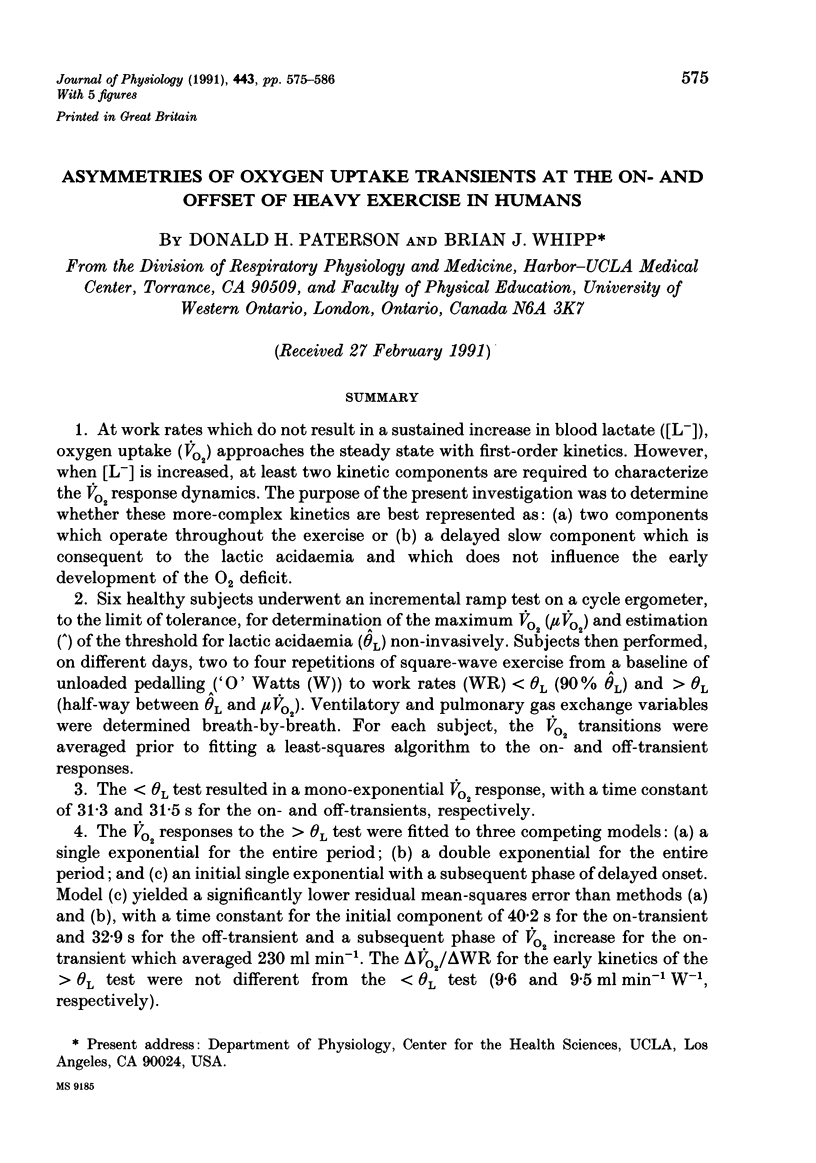
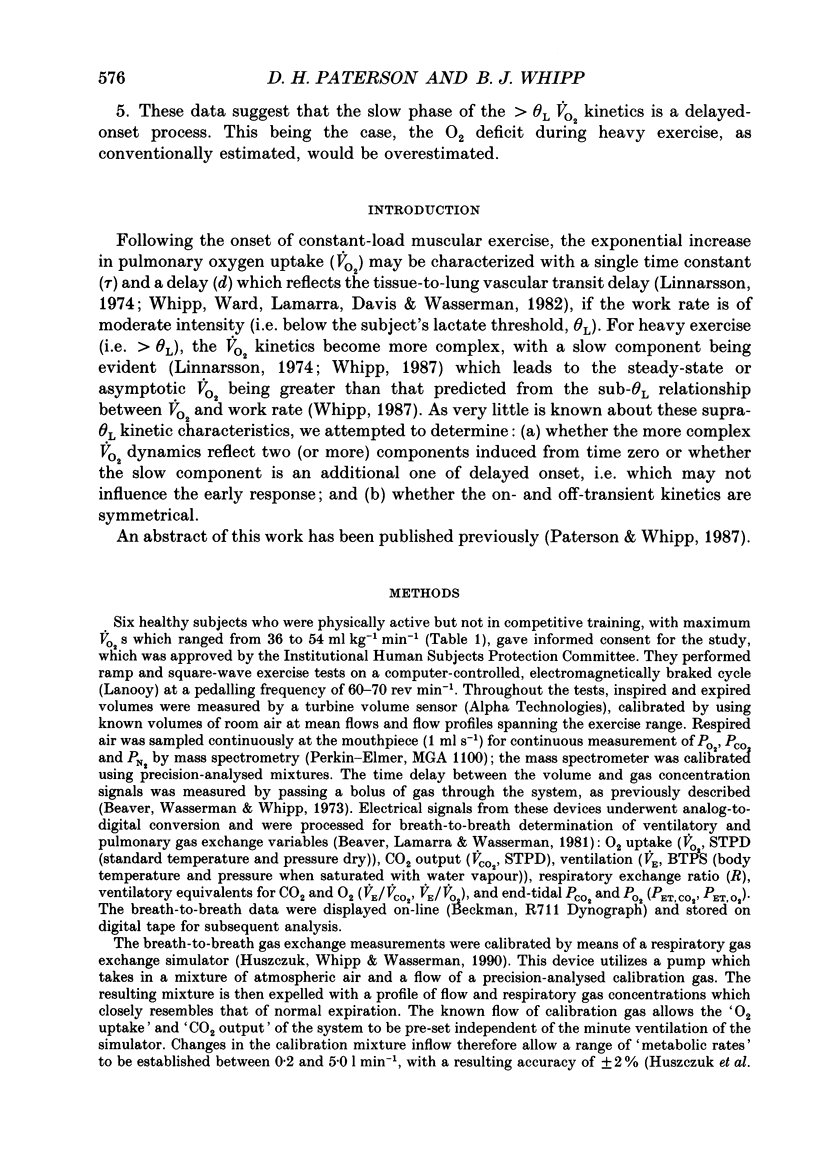
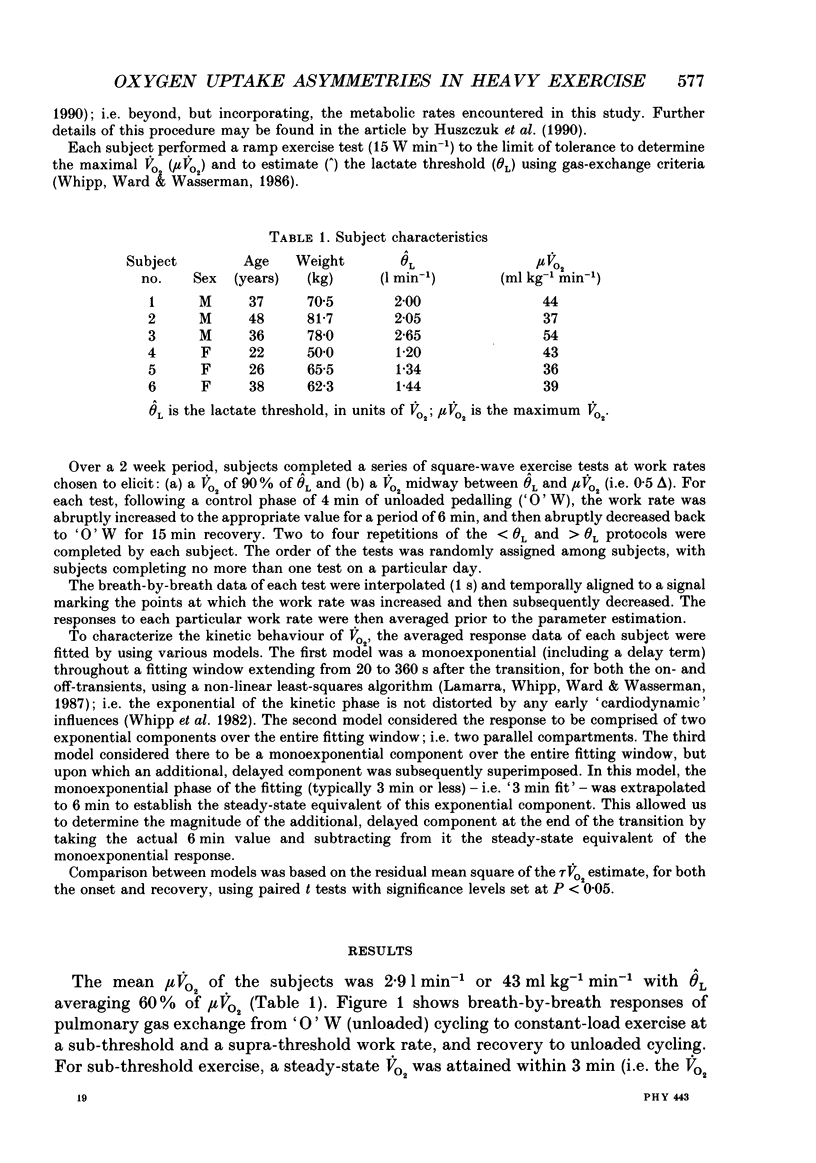
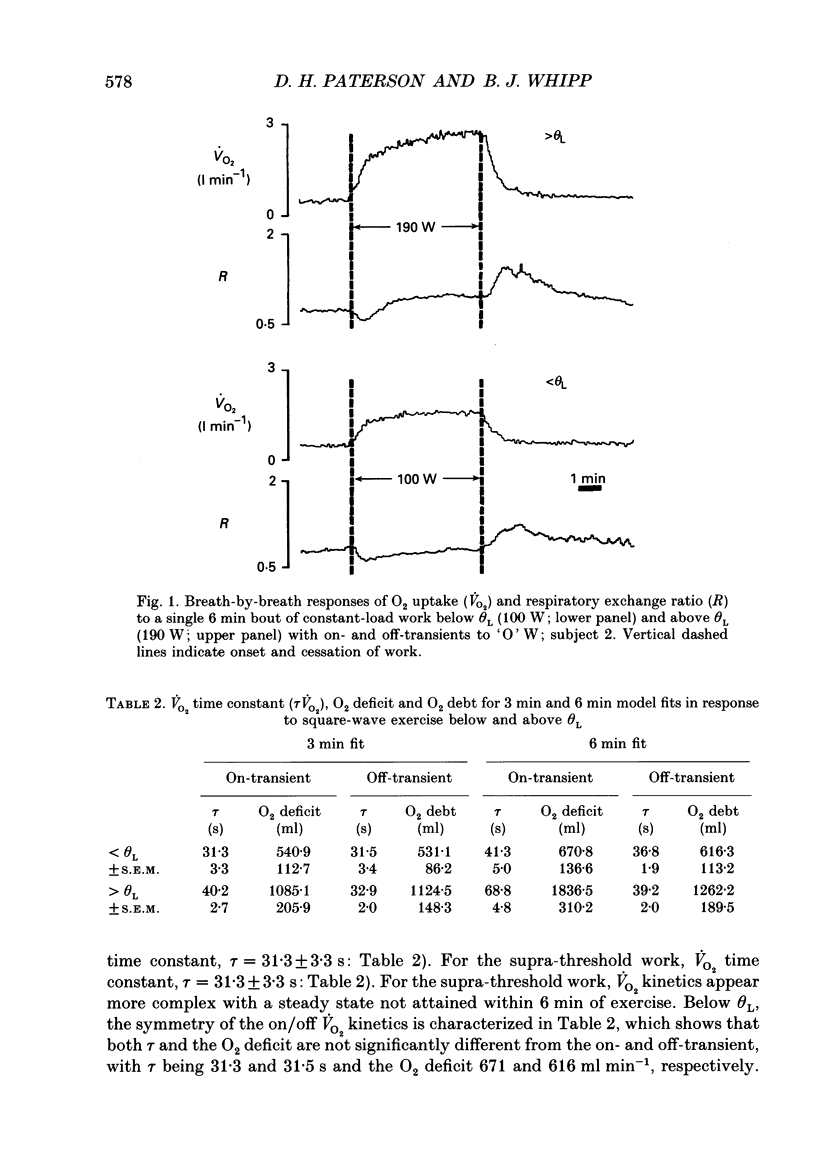
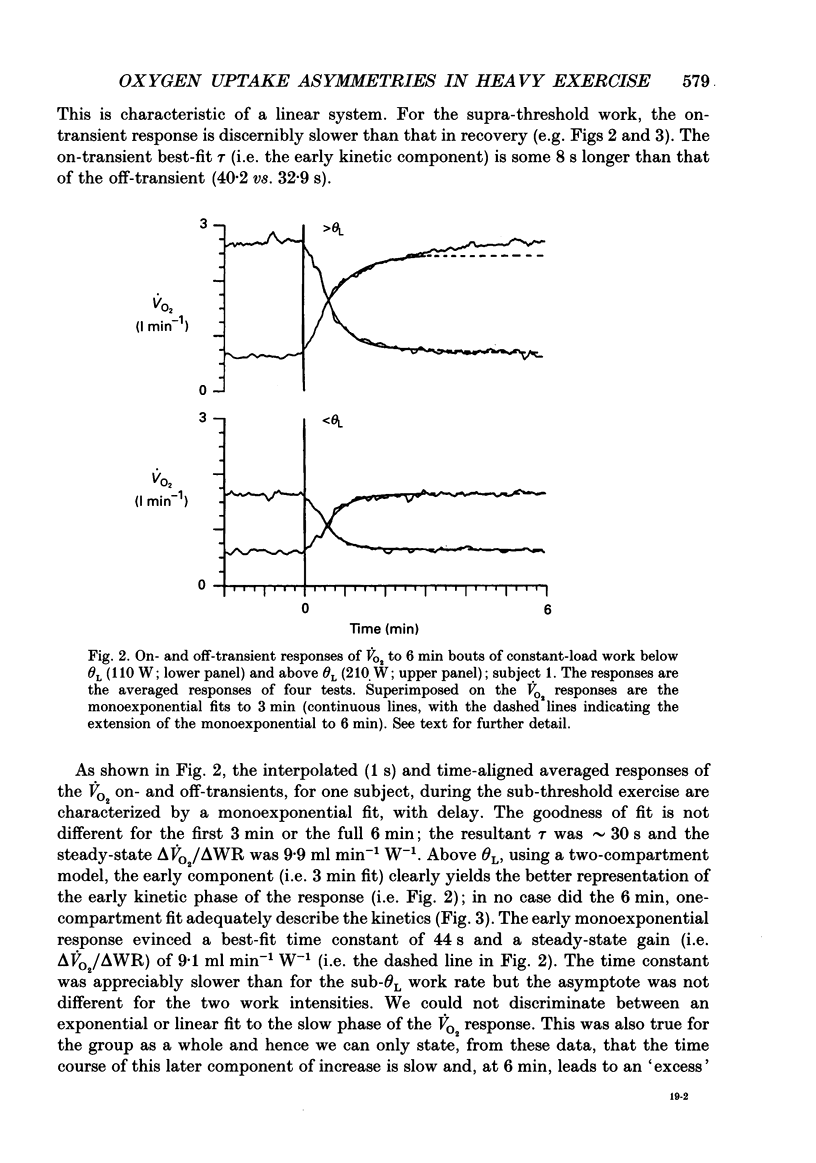
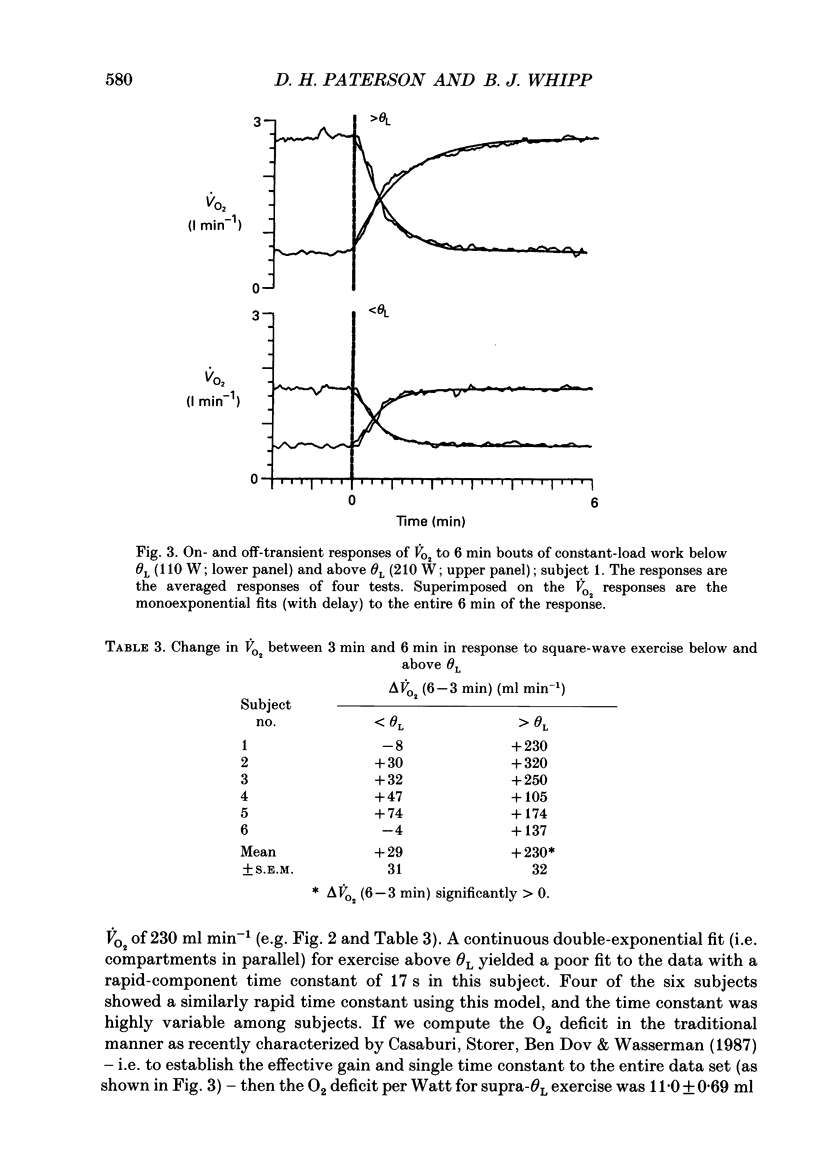
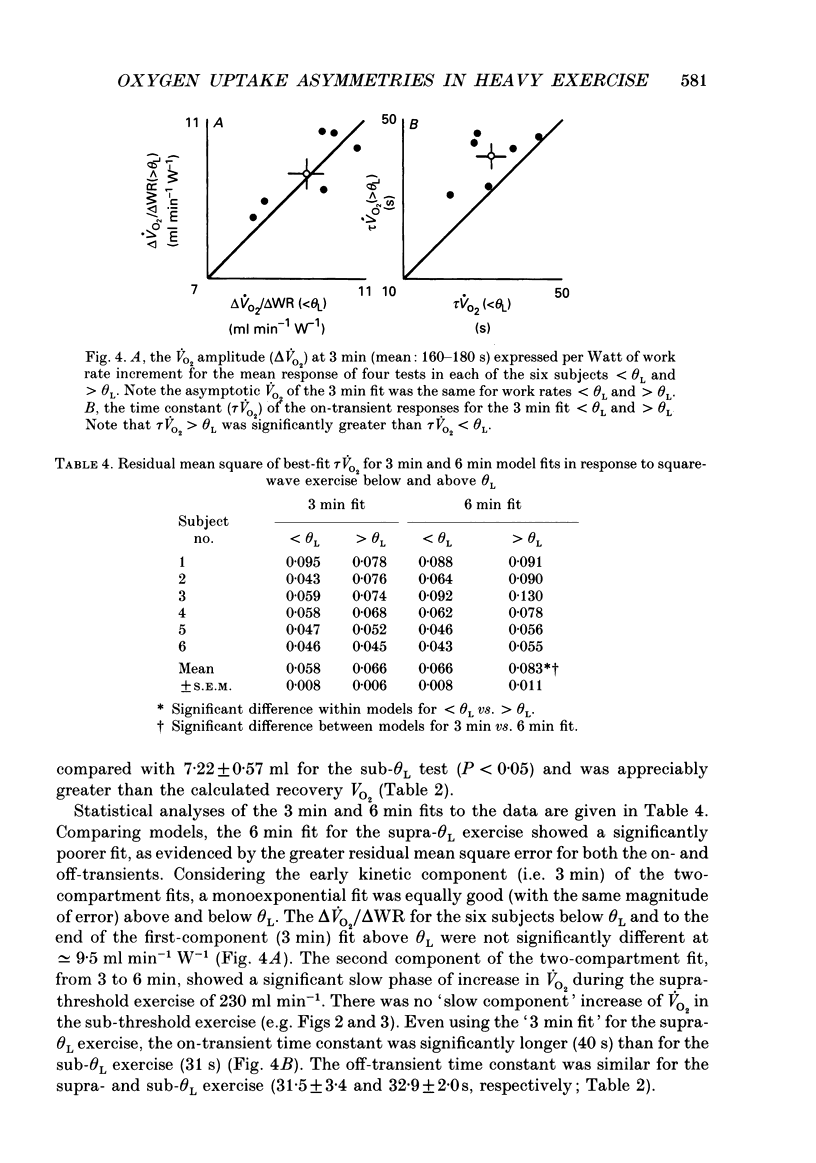
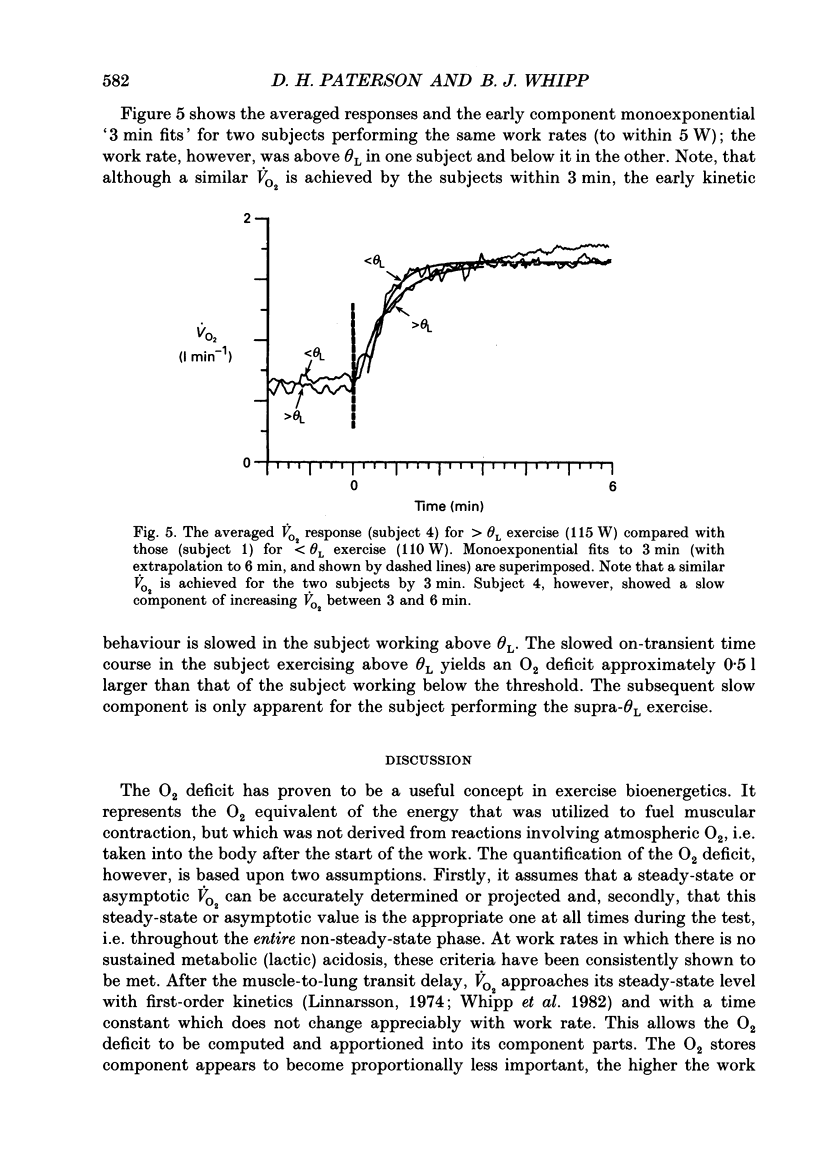
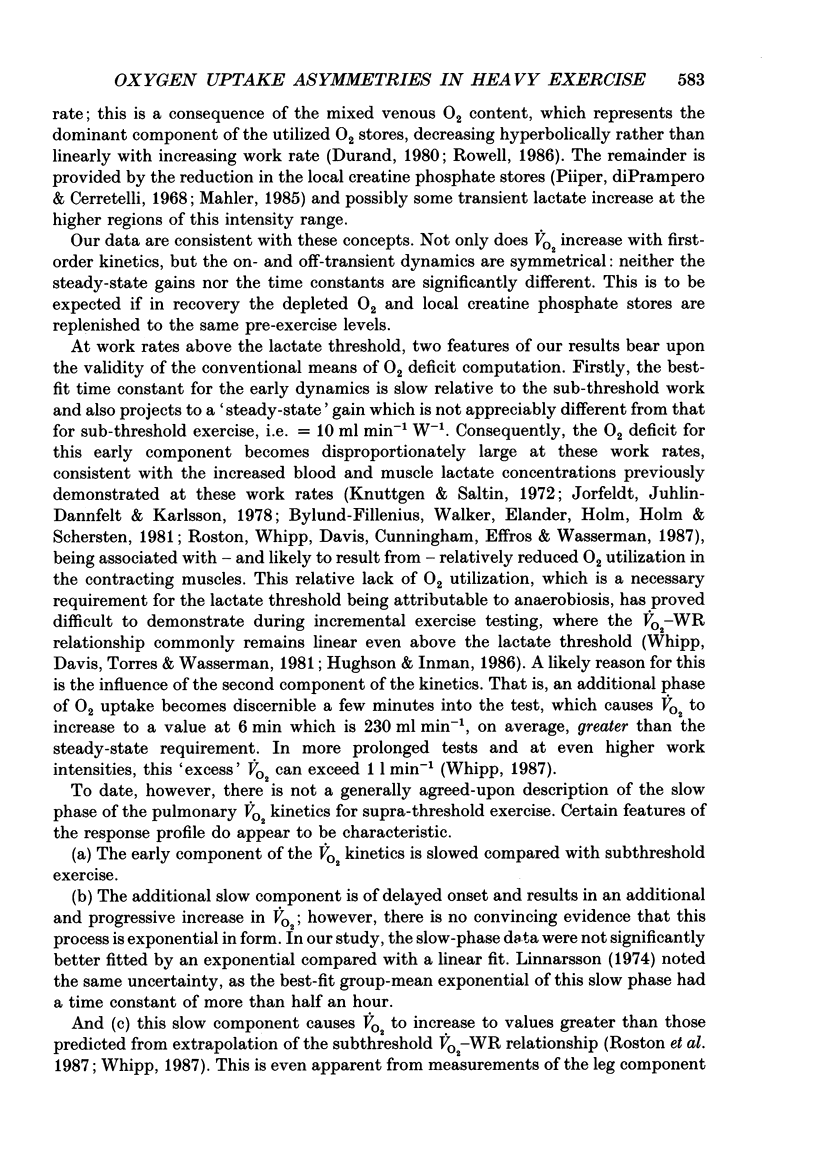
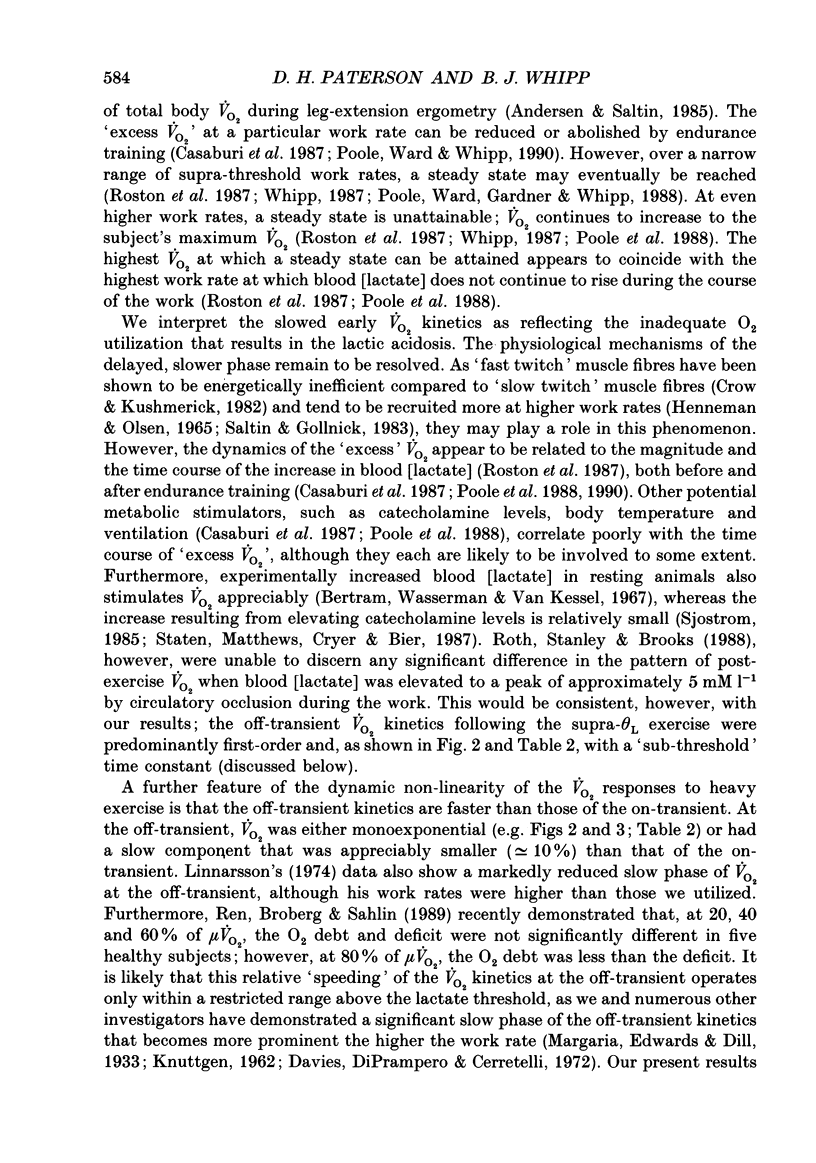
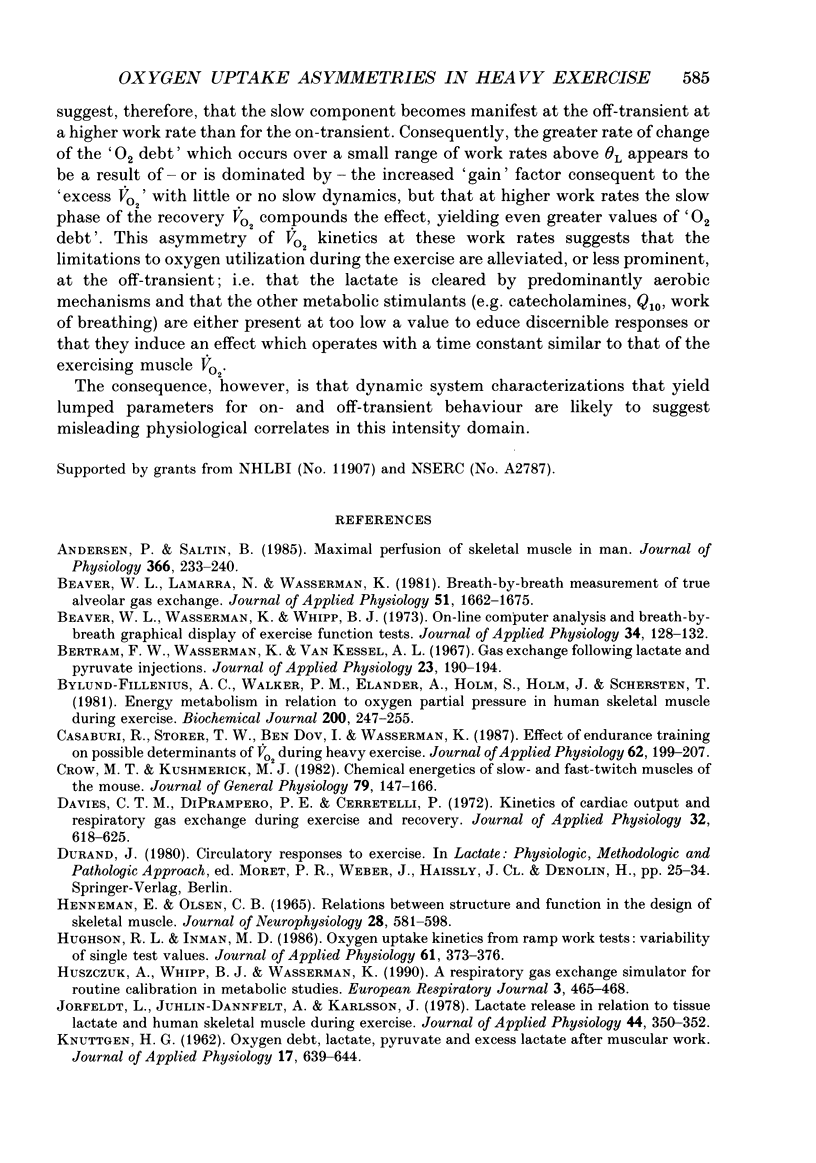
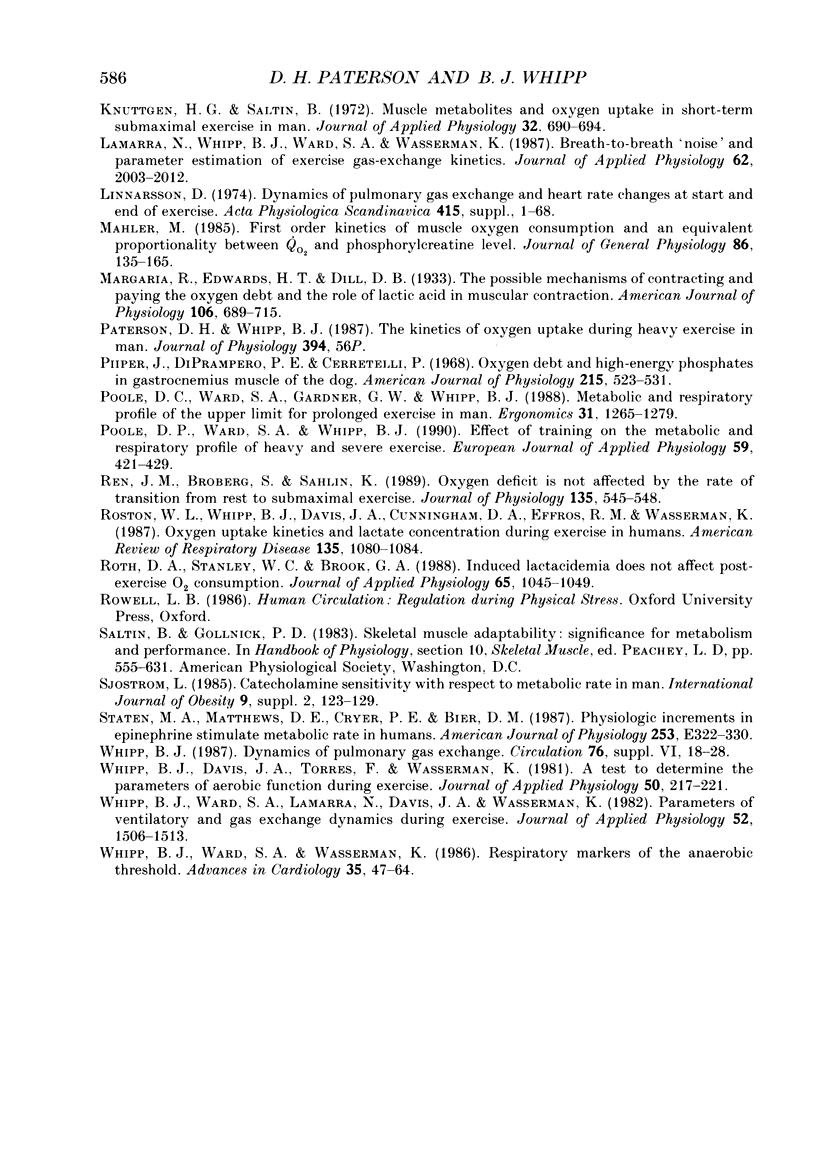
Selected References
These references are in PubMed. This may not be the complete list of references from this article.
- Andersen P., Saltin B. Maximal perfusion of skeletal muscle in man. J Physiol. 1985 Sep;366:233–249. doi: 10.1113/jphysiol.1985.sp015794. [DOI] [PMC free article] [PubMed] [Google Scholar]
- Beaver W. L., Lamarra N., Wasserman K. Breath-by-breath measurement of true alveolar gas exchange. J Appl Physiol Respir Environ Exerc Physiol. 1981 Dec;51(6):1662–1675. doi: 10.1152/jappl.1981.51.6.1662. [DOI] [PubMed] [Google Scholar]
- Beaver W. L., Wasserman K., Whipp B. J. On-line computer analysis and breath-by-breath graphical display of exercise function tests. J Appl Physiol. 1973 Jan;34(1):128–132. doi: 10.1152/jappl.1973.34.1.128. [DOI] [PubMed] [Google Scholar]
- Bertram F. W., Wasserman K., Van Kessel A. L. Gas exchange following lactate and pyruvate injections. J Appl Physiol. 1967 Aug;23(2):190–194. doi: 10.1152/jappl.1967.23.2.190. [DOI] [PubMed] [Google Scholar]
- Bylund-Fellenius A. C., Walker P. M., Elander A., Holm S., Holm J., Scherstén T. Energy metabolism in relation to oxygen partial pressure in human skeletal muscle during exercise. Biochem J. 1981 Nov 15;200(2):247–255. doi: 10.1042/bj2000247. [DOI] [PMC free article] [PubMed] [Google Scholar]
- Casaburi R., Storer T. W., Ben-Dov I., Wasserman K. Effect of endurance training on possible determinants of VO2 during heavy exercise. J Appl Physiol (1985) 1987 Jan;62(1):199–207. doi: 10.1152/jappl.1987.62.1.199. [DOI] [PubMed] [Google Scholar]
- Crow M. T., Kushmerick M. J. Chemical energetics of slow- and fast-twitch muscles of the mouse. J Gen Physiol. 1982 Jan;79(1):147–166. doi: 10.1085/jgp.79.1.147. [DOI] [PMC free article] [PubMed] [Google Scholar]
- Davies C. T., Di Prampero P. E., Cerretelli P. Kinetics of cardiac output and respiratory gas exchange during exercise and recovery. J Appl Physiol. 1972 May;32(5):618–625. doi: 10.1152/jappl.1972.32.5.618. [DOI] [PubMed] [Google Scholar]
- HENNEMAN E., OLSON C. B. RELATIONS BETWEEN STRUCTURE AND FUNCTION IN THE DESIGN OF SKELETAL MUSCLES. J Neurophysiol. 1965 May;28:581–598. doi: 10.1152/jn.1965.28.3.581. [DOI] [PubMed] [Google Scholar]
- Hughson R. L., Inman M. D. Oxygen uptake kinetics from ramp work tests: variability of single test values. J Appl Physiol (1985) 1986 Jul;61(1):373–376. doi: 10.1152/jappl.1986.61.1.373. [DOI] [PubMed] [Google Scholar]
- Huszczuk A., Whipp B. J., Wasserman K. A respiratory gas exchange simulator for routine calibration in metabolic studies. Eur Respir J. 1990 Apr;3(4):465–468. [PubMed] [Google Scholar]
- Jorfeldt L., Juhlin-Dannfelt A., Karlsson J. Lactate release in relation to tissue lactate in human skeletal muscle during exercise. J Appl Physiol Respir Environ Exerc Physiol. 1978 Mar;44(3):350–352. doi: 10.1152/jappl.1978.44.3.350. [DOI] [PubMed] [Google Scholar]
- KNUTTGEN H. G. Oxygen debt, lactate, pyruvate, and excess lactate after muscular work. J Appl Physiol. 1962 Jul;17:639–644. doi: 10.1152/jappl.1962.17.4.639. [DOI] [PubMed] [Google Scholar]
- Knuttgen H. G., Saltin B. Muscle metabolites and oxygen uptake in short-term submaximal exercise in man. J Appl Physiol. 1972 May;32(5):690–694. doi: 10.1152/jappl.1972.32.5.690. [DOI] [PubMed] [Google Scholar]
- Lamarra N., Whipp B. J., Ward S. A., Wasserman K. Effect of interbreath fluctuations on characterizing exercise gas exchange kinetics. J Appl Physiol (1985) 1987 May;62(5):2003–2012. doi: 10.1152/jappl.1987.62.5.2003. [DOI] [PubMed] [Google Scholar]
- Piiper J., Di Prampero P. E., Cerretelli P. Oxygen debt and high-energy phosphates in gastrocnemius muscle of the dog. Am J Physiol. 1968 Sep;215(3):523–531. doi: 10.1152/ajplegacy.1968.215.3.523. [DOI] [PubMed] [Google Scholar]
- Poole D. C., Ward S. A., Gardner G. W., Whipp B. J. Metabolic and respiratory profile of the upper limit for prolonged exercise in man. Ergonomics. 1988 Sep;31(9):1265–1279. doi: 10.1080/00140138808966766. [DOI] [PubMed] [Google Scholar]
- Poole D. C., Ward S. A., Whipp B. J. The effects of training on the metabolic and respiratory profile of high-intensity cycle ergometer exercise. Eur J Appl Physiol Occup Physiol. 1990;59(6):421–429. doi: 10.1007/BF02388623. [DOI] [PubMed] [Google Scholar]
- Ren J. M., Broberg S., Sahlin K. Oxygen deficit is not affected by the rate of transition from rest to submaximal exercise. Acta Physiol Scand. 1989 Apr;135(4):545–548. doi: 10.1111/j.1748-1716.1989.tb08614.x. [DOI] [PubMed] [Google Scholar]
- Roston W. L., Whipp B. J., Davis J. A., Cunningham D. A., Effros R. M., Wasserman K. Oxygen uptake kinetics and lactate concentration during exercise in humans. Am Rev Respir Dis. 1987 May;135(5):1080–1084. doi: 10.1164/arrd.1987.135.5.1080. [DOI] [PubMed] [Google Scholar]
- Roth D. A., Stanley W. C., Brooks G. A. Induced lactacidemia does not affect postexercise O2 consumption. J Appl Physiol (1985) 1988 Sep;65(3):1045–1049. doi: 10.1152/jappl.1988.65.3.1045. [DOI] [PubMed] [Google Scholar]
- Sjöström L. Catecholamine sensitivity with respect to metabolic rate in man. Int J Obes. 1985;9 (Suppl 2):123–129. [PubMed] [Google Scholar]
- Staten M. A., Matthews D. E., Cryer P. E., Bier D. M. Physiological increments in epinephrine stimulate metabolic rate in humans. Am J Physiol. 1987 Sep;253(3 Pt 1):E322–E330. doi: 10.1152/ajpendo.1987.253.3.E322. [DOI] [PubMed] [Google Scholar]
- Whipp B. J., Davis J. A., Torres F., Wasserman K. A test to determine parameters of aerobic function during exercise. J Appl Physiol Respir Environ Exerc Physiol. 1981 Jan;50(1):217–221. doi: 10.1152/jappl.1981.50.1.217. [DOI] [PubMed] [Google Scholar]
- Whipp B. J., Ward S. A., Lamarra N., Davis J. A., Wasserman K. Parameters of ventilatory and gas exchange dynamics during exercise. J Appl Physiol Respir Environ Exerc Physiol. 1982 Jun;52(6):1506–1513. doi: 10.1152/jappl.1982.52.6.1506. [DOI] [PubMed] [Google Scholar]
- Whipp B. J., Ward S. A., Wasserman K. Respiratory markers of the anaerobic threshold. Adv Cardiol. 1986;35:47–64. doi: 10.1159/000413438. [DOI] [PubMed] [Google Scholar]


